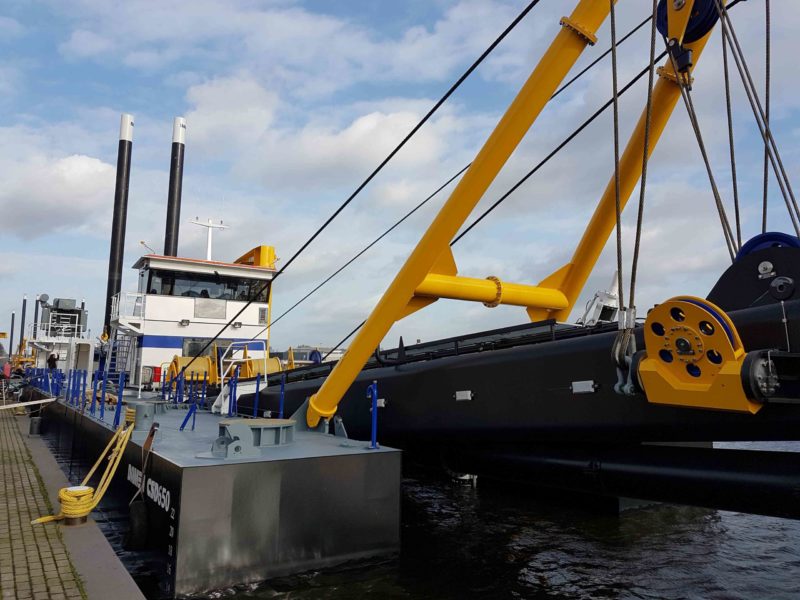Damen Shipyards Group has unveiled its first electric cutter suction dredger (ECSD 650). With electric motors powering the dredge system, the ECSD 650 makes possible zero emissions dredging projects. The electric power provides a significant reduction in noise, adding an extra tier of sustainability and ensuring the dredger’s suitability for projects in densely populated and environmentally sensitive areas, shipyard officials said.
The ECSD is a modular dredger, dismountable for transportation and easy assembly in remote locations. Due to the standardization of the design, Damen was able to very quickly produce this sustainable product, simply exchanging the diesel motors for electric ones, without need for re-engineering. Standardization further ensures the easy adaption of the ECSD to suit local power supplies, according to officials.
On the conventional CSD 650, the rear side pontoons serve only to provide buoyancy; in the ECSD the starboard side pontoon becomes an electrical nerve center. The dredger’s low voltage system equals easy maintenance with no requirement for special crew training. Meanwhile, the associated reduction in vibrations during dredging ensure a comfortable experience for those on board, shipyard officials said.
“The ECSD is just one example of the products and services that Damen is pioneering as we fix our focus on our goal: to be the most sustainable shipbuilder,” Damen sales manager Sjoerd de Bruijn said in a statement announcing the new dredge. “Our role in this is not just to build electric vessels. As integrator we provide the connection, linking and aligning stakeholders from industry and academia. In this way we build a knowledge network that encourages the wider development of sustainable solutions and ensures the long-term viability of the maritime industry.”
Damen’s work on the electrification of the maritime industry falls under the so-called E3 umbrella. That is, environmentally friendly, efficient in operation and economically viable. The shipyards group is currently working on a number of projects for electric vessels.
This includes seven fully electric Damen Ferries 2306 E3 for Copenhagen, Denmark. These ferries have a completely emission-free propulsion system, which will reduce the total emission of public transport in Copenhagen by 2.5% for CO2, 10% for NOx and 66% for particulate matter. Damen is also building two road ferries, the 6819 E3 and 9819 E3, to operate in Ontario, Canada. These will be the first fully electric ferries to operate in North America and will reduce CO2 emissions by as much as 7 million kg per year.
The six Island-class ferries — road ferries 8117 E3 — that Damen is building for BC Ferries in British Columbia, Canada, will sail with a hybrid propulsion system that can be easily converted to full electric in the future when the appropriate infrastructure is in place locally.
An order from the Port of Auckland, New Zealand, sees Damen constructing the world’s first fully-electric ship-handling tug with 70 tonnes bollard pull. The RSD tug 2513 was already an exercise in sustainability, being fully prepared for IMO Tier III compliance and featuring numerous energy-conscious characteristics running throughout its design. With 80% of electricity in New Zealand coming from wind and hydropower, Damen’s tug completes the circle in a zero emissions operation, according to shipyard officials.





